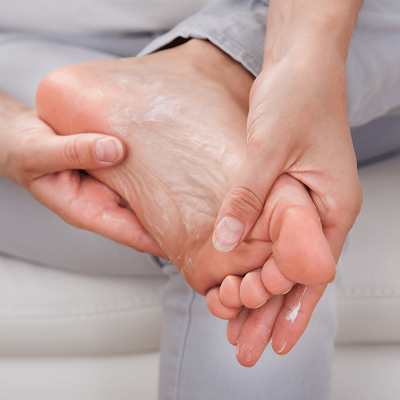Diabetes has its own set of difficulties, one of which is problems with the feet. Your ability to do everyday tasks may be hampered by diabetic foot wounds, which are upsetting. However, empowering people with diabetes to take charge of their foot health through Diabetic Wound Care at Home is a developing trend in Abu Dhabi.
Quick Facts
- Cost-effective.
- Safe surroundings.
- Problem-solving approach.
Table of Content
What is a Diabetic FootCare?
It is a comprehensive strategy for addressing existing wounds and minimizing foot issues in diabetics known as Diabetic Foot Care. Maintaining feet, sidestepping troubles, and lowering the chance of amputation. Individuals’ blood circulation will be improved, lessen nerve injury, and assure quick detection and treatment of foot problems by implementing basic foot care practices.
Foot Problems’ Symptoms and Signs:
It’s important to stay alert and recognize the warning signs and symptoms. Some typical signs include:
- Tingling or numbness in the feet.
- Open sores, blisters, or wounds that take a while to heal.
- Foot enlargement, warmth, or redness.
- Ingrown toenails or fungus
- Pain or discomfort whether walking or relaxing.
- Anomalies or alterations in the foot’s form.
What are the Advantages of Home Diabetic Footcare?
There are several benefits, a few of which are mentioned below:
Convenience: By choosing to manage their diabetic foot care at home healthcare services, people may do it in the comfort of their own homes and avoid making frequent clinic trips.
Cost-effectiveness: Homecare provides a more inexpensive option, cutting down on the medical costs linked to frequent clinic visits.
Independence: Taking responsibility for the health of your feet gives you the freedom to decide how to look after your feet daily, promoting a sense of independence and control.
Prevention: Taking good care of your feet at home regularly lowers your chances of issues like infections and ulcers while increasing overall foot health.
Faster Healing: Consistent foot care practices aid With prompt detection which promotes quicker healing and lowers the risk of dangerous infections.
Diabetic Sores!
The most typical places for diabetic sores on feet, also known as foot ulcers, are the soles or flanks of the feet. It is a common issue for diabetics and can be caused by trauma, neuropathy (nerve damage), and poor circulation, among other factors. They need to be treated as soon as possible in order to get rid of infection.
Treatment of Diabetic Wounds on Feet:
To promote healing and minimize complications, Diabetic Wounds may be treated using a mix of techniques:
Cleaning or Dressing: Maintaining a sterile environment, preventing infections, and promoting healing all depend on the wound being cleaned and dressed properly.
Offloading: Pressure on the injured foot will be reduced and speed up recovery by using special shoes, braces, or inserts.
Infection control: Antibiotics or other therapies may be recommended if an infection is present to address the underlying problem.
Blood Sugar Control: The healing process is greatly aided by maintaining healthy blood sugar stores. There may need to be close observation and medication modifications.
Advanced Wound Care: For complicated or slow-healing wounds, advanced wound care procedures, such as negative pressure wound therapy or bioengineered skin replacements, may be advised.
Why it is Necessary?
Due to the increased chances of foot issues in individuals with diabetes, it is essential to take proper care of your feet. Serious effects, such as infections, ulcers, and, in extreme circumstances, amputation, can result from neglecting foot health. People may retain their mobility, independence, and general quality of life by giving their feet the attention they need.
AfterCare:
For long-term foot health and recurrence prevention, proper aftercare is essential. Following are some crucial aftercare guidelines:
Regular Foot Inspections: Find any indications of redness, blisters, or cuts on feet daily. Seek medical treatment as soon as possible if you spot any anomalies.
Hygiene: Save your feet dry and clean, giving special awareness to the spaces in your toes. Avoid wetting them since it might generate the skin to dry out too much.
Proper Nail care: you prevent ingrown toenails, be sure you cut your toenails directly across and without cutting them too quickly.
Moisturize: Apply a little moisturizer to your feet to keep the skin nourished and guard against dryness and cracking.
Cost:
The cost of Diabetic foot care at Enfield Royal Clinic may vary depending on different factors, and the specific price will be determined after the initial consultation with the doctor.
Factors Affecting Cost:
- Quality used.
- At-home services.
- Distance from the clinic
Take Steps Towards Healthier Feet by Choosing Us!
We take great pride in our clinic, where we have a team of highly skilled professionals who are fully dedicated to addressing every aspect of Diabetic Foot Care At Home in Abu Dhabi. Whether it’s focusing on preventive measures or effective management, we provide comprehensive services in a comfortable and welcoming environment.
Book us now!
Visit our clinic to start along the path to better feet. Our devoted team is prepared to offer knowledgeable advice and assistance in controlling Diabetic Sores on the Feet. Don’t allow foot issues to stop you from moving forward.
FAQ’s:
How frequently should I examine my feet?
It is advised that inspect your feet on a day-to-day basis. Spend some time completely inspecting your feet, paying special attention to tops, soles, and spaces in between the toes.
How many foot ulcers be sidestepped?
It's crucial to take several measures to minimize ulcers. Inspect your feet every day, wear the right shoes, keep them clean and moisturized, and stay out of the sun and harsh heat.
What is the healing time for diabetic foot wounds?
How soon diabetic foot wounds heal depends on a variety of factors, including the size of the lesion, overall health, and adherence to advised wound care.









 Start
Start